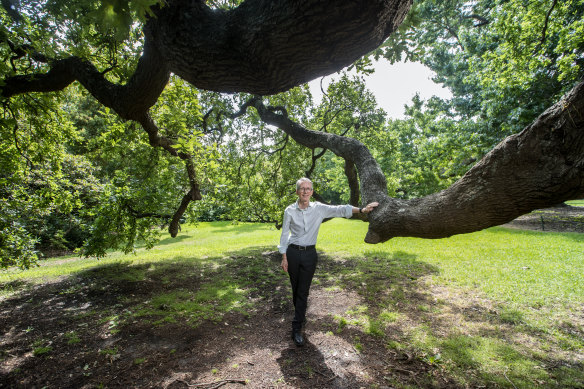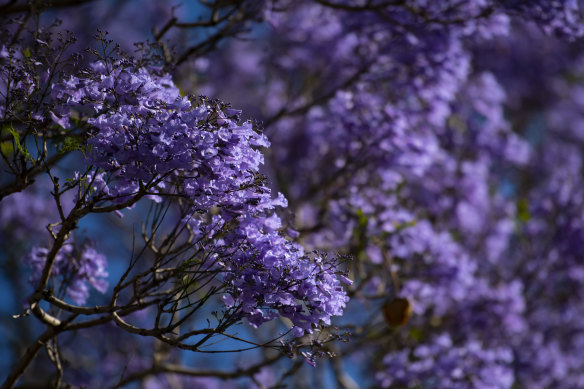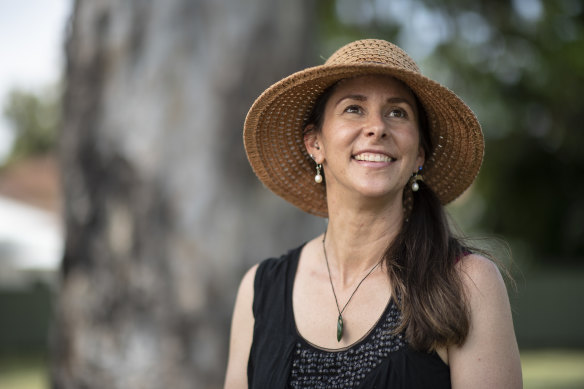This was published 3 years ago
As Melbourne heats up, the city’s trees are changing
By Cara Waters
With Melbourne’s temperatures continuing to heat up to resemble a climate more like Dubbo’s, some species of trees will thrive while others will struggle to survive.
The city’s streetscapes are set to change with large plane trees and English oaks making way for more indigenous trees and species suited to warmer climates like jacarandas and South American leopard trees.
Royal Botanic Gardens of Victoria chief executive Tim Entwisle said gardens staff had changed their method of planting in response to climate change, with every tree now assessed on the temperature and rainfall of its native environment compared with Melbourne’s predicted climate.

Tim Entwisle, chief executive of the Royal Botanic Gardens.Credit: Simon Schluter
“In the next 70 years, we know there is going to be less rainfall and our climate is going to be more like Dubbo and so we have to reorientate our plantings to fit that,” he said. “We’re actually not going to plant certain trees if they come up as looking like they won’t survive in the modern climate.”
Mr Entwisle said he was particularly concerned about the number of days over 35 degrees, which by 2050 is projected to increase dramatically to an extra 13 days a year.
“That is going to knock a lot of species out,” he said.
He warned elm trees and popular species of oak trees would not survive if the climate warmed up, while trees like cape chestnuts Calodendrum capense, jacarandas Jacaranda mimosifolia and silk floss trees Ceiba speciosa from Buenos Aires were all likely to do better in Melbourne than they have in the past.

Jacarandas in full bloom are a common sight in Sydney and are more likely to be seen in Melbourne in the future. Credit: Wolter Peeters
“People love oak trees, they are big shady trees, they keep areas cool but when we replace an oak tree now in our oak lawn we are more likely to plant a different kind of oak,” he said. “Instead of an English oak we might plant what we call an Algerian oak, one that’s better adapted to the drier climate.”
The response to climate change isn’t as simple as just planting more indigenous trees, with research published by Western Sydney University this year finding many would only survive hotter temperatures with more attention, shade and water – a resource expected to be rarer and more expensive in the future.
Researchers tested 20 popular native plants from across Australia to see how they fared in drought and heatwave conditions and found some died, including a Banksia robur and a bottlebrush Callistemon, while others struggled.

Researcher Dr Renee Marchin Prokopavicius has just published a range of research on plant heat and drought tolerance.Credit: Wolter Peeters
Researcher Dr Renee Prokopavicius said researchers could recommend tolerant species, but they didn’t always match up to those species best for planting in cities.
“Drought tolerant species are often slow growing and they have smaller leaves and that’s not ideal for street trees that provide shading – you would prefer faster growing, large, lots of leaf area and dense canopy” she said.
University of Melbourne arboriculture expert Greg Moore said the Sydney research showed indigenous trees in Melbourne such as shrubby grevilleas and bottlebrush might struggle without water in the future.
However, commonly planted trees in Melbourne including spotted gums Corymbia maculata, yellow gums Eucalyptus leucoxylon, and sugar gums Eucalyptus cladocalyx were all “tough customers” and likely to be more resilient.
The state government pledged $5 million last year for planting 500,000 trees to cool Melbourne’s west, which has significantly less canopy cover than other areas of the city.
The City of Melbourne is aiming to increase its canopy cover to 40 per cent by 2040 by planting more than 3000 trees per year.
A council spokeswoman said a primary focus was increasing tree diversity and the City of Melbourne was introducing species that could better cope with hotter weather including those which have never existed in Melbourne but perform well in similar or warmer climates in Australia or abroad.
Recent plantings on Southbank Boulevard, University Square Carlton and Park Street in Parkville include a mix of indigenous plantings such as black she oaks Allocasuarina littoralis and wattles Acacias, native plantings such as sandpaper figs Ficus coronata, hakea species, bottletrees Brachychiton and introduced species such as Leopard trees Libidibia ferrea, Cottonwoods Populus deltoides and Puriri Vitex lucens.
However, Dr Moore said he was concerned that while new plantings were occurring, new constructions and infrastructure projects were taking out tens of thousands of trees across Melbourne.
“You’re losing lots of mature trees, and you’re planting lots of little ones and it’s going to be a long time before those little trees really make much of a difference,” he said.
Dr Moore said Melbourne was losing about 1 per cent of its tree canopy cover each year mainly because of the redevelopment of larger, older blocks and this impacted both the environment and people’s health.
“There are basically Melbourne suburbs with not a tree to be seen,” he said. “And those are places that have very high temperatures already in summer.”
A guide to the environment, what’s happening to it, what’s being done about it and what it means for the future. Sign up to our fortnightly Clear Air newsletter here.